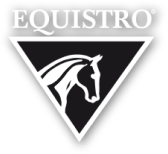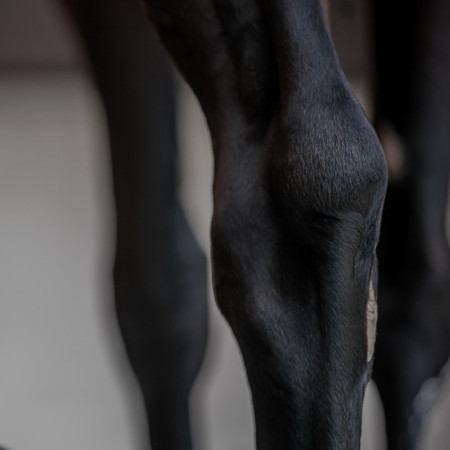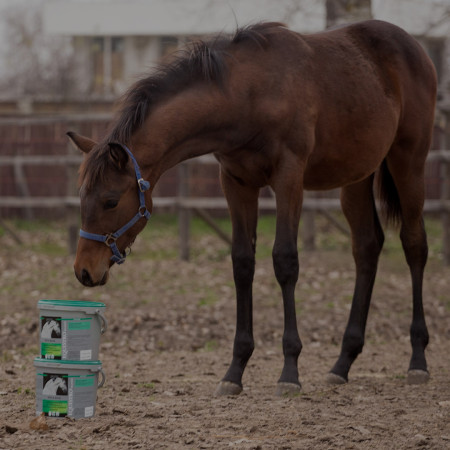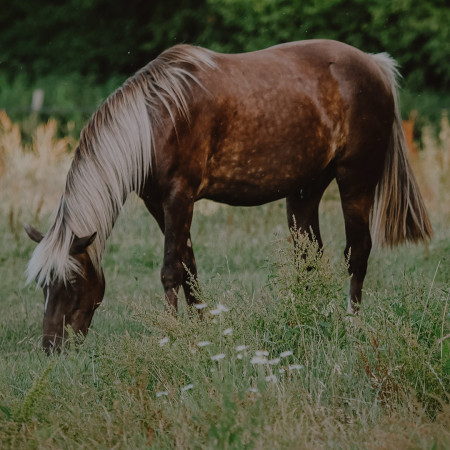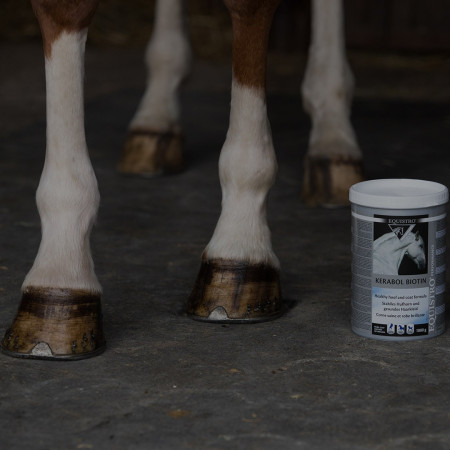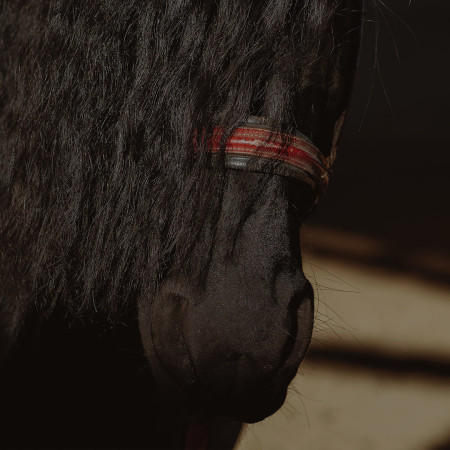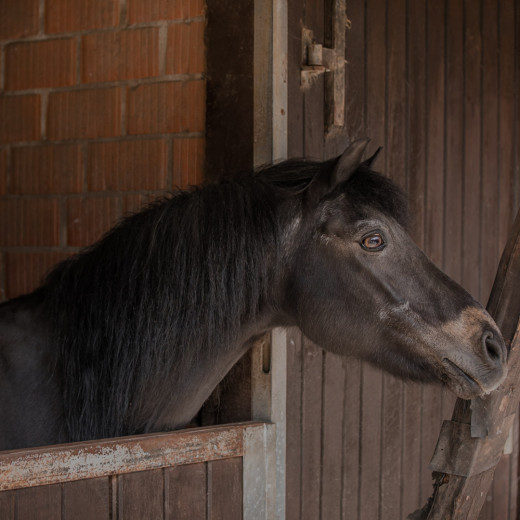
Nutritional challenges in senior horses
Horses with an age of more than 20 years are generally defined as senior horses, but thanks to the progress in veterinary medicine, feeding management and overall housing conditions, senior horses have a lot of possibilities to enjoy a high quality of life when becoming old. A healthy lifestyle, including physical activity and a well-balanced diet play an important role in a healthful aging process.
Overall nutritional considerations
Aged horses are dependent on dietary adjustments that support changing dentition, possible increase of intestinal malabsorption, and boosting the immune system. Feed types remain mostly the same, but the horse’s ability to chew and digest feed stuffs may change. As energy intake, protein, vitamin and mineral requirements often slightly change, the diet of senior horses should be optimized by adapting the daily ration with specific nutrients to support an active senior horse life. Because the aged horse’s metabolism needs more time for adaptions, feed changes should be made step by step during a 10–14-day period to allow a smooth adjustment of metabolism and hindgut microbiome.
Roughage is king
Roughage should be fed at a rate of 2% of the horse’s body weight per day. Grass, hay and straw promote intestinal motility and require more salivation, helping to buffer gastric acid. Salivary enzyme production can decline in aged horses, limiting the ability to properly digest carbohydrates (e.g., starch), depriving the horse of essential nutrients. Furthermore, undigested carbohydrates (e.g., starch, sugar) from the small intestine are at risk to enter the cecum, disrupting the pH, alter the microbiome and mediate cecum acidosis which can result in endotoxemia, laminitis and colic. Less saliva production can lead to reduced chewing activity which can be counterbalanced by moistening the horse’s feed with water to increase chewing activity and elevate the daily feed and water intake.
In the context of aging, the horse’s hindgut can be affected by some changes like reduced ability to ferment fibre resulting in lower nutrient intake and depletion of the microbiome. Adding young and leafier hay to the horse’s daily diet to replace stemmy, older hay cuttings, can simplify chewing and improve nutrient absorption in the small intestine.
Mixing different types of roughage (hay, straw, grass) can offer a better variety of essential nutrients. Hay nets or slow feeders enable 24/7 access to roughage and allow the adjustment of chewing speed, which is often reduced in seniors. Horses with senile teeth need to be fed similar amounts of hay or grass cobs (soaked in water) like roughage to replace the daily intake of calories and protein for their maintenance missing from lack of roughage chewing ability. But horses with senile teeth who can’t chew properly need to have access to roughage nevertheless for satisfying their chewing desire.
Horses with daily access to pasture turnout to be less stressed and at lower risk of suffering from gastric ulcers or colic. If a grazing pasture is not available, hand grazing horses for 30-minute sessions multiple times a day also is a possible option to at least satisfy their chewing and grazing desire.
Keep the balance
Older horses fed a roughage-based diet need to be supplemented with essential vitamins and minerals. To balance a hay-only diet for horses that do not require additional calories, a supplement rich in high-quality amino acids (e.g., MYO POWER), trace minerals and vitamins (e.g., MEGA BASE & HAEMOLYTAN) should be considered.
High-quality protein is of high importance especially in senior horses. Protein quality and digestibility depends on the amino acid profile of the fodder, with lysine being the first-limiting amino acid. Supplementing lysine and other essential amino acids (e.g., with MYO POWER) help to maintain and rebuild muscle mass.
Senior horses also should be continuously provided with electrolytes (e.g., ELECTROLYT 7) and fresh water to not put their cardiovascular system under stress in extreme hot or cold temperatures.
Probiotics - Little helpers with large effects
Probiotics are vital microorganisms with many benefits to the horse beyond their nutritive value. They can boost microbiological fibre digestion, improve fermentative process efficiency, and increase mineral absorption in the large colon of the horse. The most common and only approved probiotic for horses is Saccharomyces cerevisiae, a yeast species that optimizes the balance of fibre and starch digestion in the large colon. Enriching the horse’s diet with S. cerevisiae (contained in MEGA BASE) can help to keep the pH in the cecum especially in horses fed diets high in starch. Adding S. cerevisiae to the daily diet can also be beneficial for senior horses in supporting the immune system’s activity.
Radical oxidateive stress reduction
Beside many factors, free radical accumulation is suspicious to speed up aging processes by harming cell membrane layers which is called oxidative stress and has been implicated in many health disorders in horses. Free radicals promote the degradation of muscle cells, connective tissue as well as joint components and should be eliminated from the horse’s organism properly with help of antioxidants like vitamin C, E and selenium.
Beside the well-known antioxidant effects of vitamin C for maintaining a health function of the immune system, it can help to protect joint structures from oxidative stress. Vitamin C is synthesized in the horse’s liver in sufficient levels but can decrease in aged horses due to reduced liver function.
Supplementation with vitamin E (e.g., EXCELL E, TRIFORCE) is recommended for aging horses as it provides potent antioxidant properties for the locomotor system, nerves and the vascular system. Vitamin E also can support the defence mechanisms of the respiratory system.
Selenium is an essential component of the enzyme glutathione peroxidase which plays a leading role in protecting cell membrane layers from free radicals. As an adequate selenium intake cannot be assumed on typical forage provided to horses – and cereal grains which have a low selenium content as well – supplementation is highly recommended (e.g., EXCELL E) to prevent selenium deficiency.
Long-life joint flexibility for maximum mobility comfort
One main goal in aging horses is to maintain joint mobility enabling a convenient life for the senior without any trouble. Joint discomfort like stiffness often comes along with the natural aging process. Although most joint disorders are located in the horse’s legs, attention also need to be paid to the facet joints in the neck, back and the hip joints, especially in (former) high performance horses.
Specific nutrients can provide support for intermittent joint stiffness and discomfort in aging horses. Especially antioxidants, cartilage-building and immunomodulating nutrients can help to support joint mobility in senior horses. Glucosamine (e.g., ARTPHYTON) is a precursor of glycosaminoglycans and an essential building brick of the extracellular matrix of joint cartilage. Due to its anti-inflammatory properties, devil's claw (e.g., ARTPHYTON) can be a valuable support as well especially in cases of chronic joint discomfort in order to improve the horse's mobility and quality of life.
Nutrients with immunomodulating effects (e.g., FLEXADIN & FLEXADIN ADVANCED) can also help to improve the quality of life in elder horses by down-regulating discomfortable processes limiting joint mobility.
Dr. med. vet. Caroline Fritz
